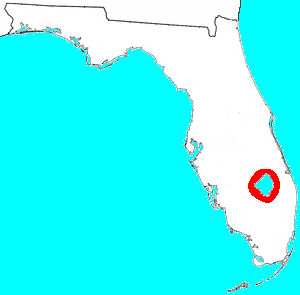Mayaimi facts for kids
The Mayaimi (say: My-AH-mee) were a group of Native American people. They lived around a large lake in Florida, which they called Lake Mayaimi. Today, this lake is known as Lake Okeechobee. The Mayaimi people lived there from around the year 0 until the 1700s. In their language, and in the languages of nearby tribes like the Calusa and Tequesta, "Mayaimi" meant "big water."
We don't know much about the Mayaimi language because only a few words were written down before it disappeared. The current name for the lake, Okeechobee, also means "big water" in the Hitchiti language. The city of Miami gets its name from the Miami River, which was named after Lake Mayaimi. The Mayaimi people are not related to the Miami people who lived near the Great Lakes.
Contents
Mayaimi History and Lifestyle
The Mayaimi people built special mounds of earth for their villages and ceremonies. These mounds were similar to those built by other ancient groups in the southeastern United States. One important place in their area was Fort Center.
Building Canals and Using Canoes
The Mayaimi also dug many canals. They used these canals as waterways for their dugout canoes. Their canoes were unique. They had flat, shovel-shaped ends, much like canoes found in Central America and the Caribbean. This was different from the pointed canoes used by other tribes in the southeastern United States.
What the Mayaimi Ate
A Spanish explorer named Hernando de Escalante Fontaneda lived with tribes in southern Florida in the 1500s. He said the Mayaimi lived in many small towns, each with about 30 to 40 people. There were also smaller places where only a few people lived.
The Mayaimi got most of their food from Lake Okeechobee.
- They used special traps called fishing weirs to catch fish.
- They ate fish like black bass and eels.
- They also ate alligator tails, Virginia opossum, turtles, and snakes.
- They processed a plant called coontie to make flour.
- When the water levels were high, they lived on their mounds and mostly ate fish.
Changes and Disappearance
In the early 1700s, groups from the Province of Carolina often raided Spanish Florida. They teamed up with other Native American tribes. These raiders attacked villages, capturing or killing people from all the Florida tribes, including the Mayaimi. They sold the people they captured into slavery.
- In 1710, a group of 280 people from Florida, including a Mayaimi leader, went to Cuba for safety.
- By 1738, the Mayaimi had a small fort on the coast south of Cape Canaveral.
- In 1743, Spanish missionaries reported that a small group of Mayaimi, along with other tribes, still lived north of the Miami River.
- When Spain gave up control of Florida to Britain in 1763, any remaining Mayaimi people likely moved to Cuba.
Archaeological Sites
Today, we know about several important archaeological sites in the area where the Mayaimi lived. These sites help us learn about their culture and history.
- Fort Center
- Belle Glade
- Big Mound City
- The Boynton Mounds complex
- Tony's Mound
See also
 In Spanish: Mayaimi para niños
In Spanish: Mayaimi para niños


